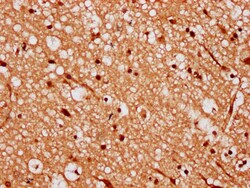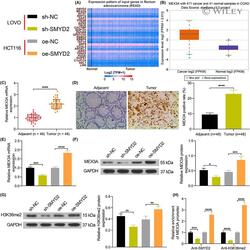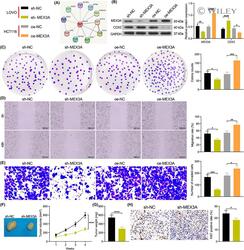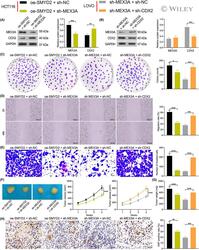Antibody data
- Antibody Data
- Antigen structure
- References [1]
- Comments [0]
- Validations
- Immunohistochemistry [1]
- Other assay [3]
Submit
Validation data
Reference
Comment
Report error
- Product number
- PA5-97968 - Provider product page

- Provider
- Invitrogen Antibodies
- Product name
- RKHD4 Polyclonal Antibody
- Antibody type
- Polyclonal
- Antigen
- Recombinant full-length protein
- Reactivity
- Human
- Host
- Rabbit
- Isotype
- IgG
- Vial size
- 100 µg
- Concentration
- 4.29 mg/mL
- Storage
- -20°C or -80°C if preferred
Submitted references SMYD2 epigenetically activates MEX3A and suppresses CDX2 in colorectal cancer cells to augment cancer growth.
Pan L, Fan Y, Zhou L
Clinical and experimental pharmacology & physiology 2022 Sep;49(9):959-969
Clinical and experimental pharmacology & physiology 2022 Sep;49(9):959-969
No comments: Submit comment
Supportive validation
- Submitted by
- Invitrogen Antibodies (provider)
- Main image

- Experimental details
- Immunohistochemical analysis of RKHD4 in paraffin embedded human brain tissue using a RKHD4 polyclonal antibody (Product # PA5-97968) at a dilution of 1:300. After dewaxing and hydration, antigen retrieval was mediated by high pressure in a citrate buffer (pH 6.0). Section was blocked with 10% normal goat serum 30min at RT. Then primary antibody (1% BSA) was incubated at 4°C overnight. The primary is detected by a biotinylated secondary antibody and visualized using an HRP conjugated SP system.
Supportive validation
- Submitted by
- Invitrogen Antibodies (provider)
- Main image

- Experimental details
- 3 FIGURE SET and MYND domain containing 2 (SMYD2) promotes Mex-3 RNA binding family member A (MEX3A) transcription through H3K36me2 modification. A, Genes showing a positive correlation with SMYD2 in colorectal cancer (CRC) and normal colonic tissues predicted in the UALCAN system; B, MEX3A expression profiling in CRC tissues and normal tissues in the StarBase Pan-cancer system; C, expression level of MEX3A in CRC tumour tissues and the adjacent normal tissues from patients examined by reverse transcription quantitative polymerase chain reaction (RT-qPCR) (n = 48; paired t test); D, expression level of SMYD2 in CRC tumour tissues and the adjacent normal tissues from patients examined by the immunohistochemistry (IHC) assay (n = 48, the paired t test); E,F, messenger RNA (mRNA), E, and protein, F, levels of MEX3A in LOVO and HCT116 cells after sh-SMYD2 or oe-SMYD2 transfection examined by RT-qPCR and Western blot analysis, respectively (one-way ANOVA); G, protein level of H3K36me2 in LOVO and HCT116 cells examined by Western blot analysis (one-way ANOVA); H, enrichment of anti-SMYD2 and anti-H3K36me2 by MEX3A promoter examined by the chromatin immunoprecipitation (ChIP)-qPCR assay (two-way ANOVA). Cellular experiments were repeated three times. * P < .05; ** P < .01; *** P < .001; **** P < .0001
- Submitted by
- Invitrogen Antibodies (provider)
- Main image

- Experimental details
- 4 FIGURE Mex-3 RNA binding family member A (MEX3A) inhibits the expression of caudal type homeobox 2 (CDX2) and promotes malignant growth of colorectal cancer (CRC) cells. A, a protein-protein interaction (PPI) network of MEX3A-related genes established using the STRING system; B, protein levels of MEX3A and CDX2 in LOVO and HCT116 cells after sh-MEX3A or oe-MEX3A transfection, respectively, examined by Western blot analysis (two-way ANOVA); C, proliferation ability of LOVO and HCT116 cells examined by the colony formation assay (one-way ANOVA); D, migration ability of cells examined by the wound-healing test (one-way ANOVA); E, invasiveness of cells examined by the Transwell assay (one-way ANOVA); F, weekly changes in the volume of xenograft tumours (two-way ANOVA); G, weight of the xenograft tumours on the 28th day (the unpaired t test); H, Ki67-positive rate in xenograft tumour tissues examined by the immunohistochemistry (IHC) assay (the unpaired t test). Cellular experiments were repeated three times. In animal experiments, n = 6 in each group. * P < .05; ** P < .01; *** P < .001; **** P < .0001
- Submitted by
- Invitrogen Antibodies (provider)
- Main image

- Experimental details
- 5 FIGURE SET and MYND domain containing 2 (SMYD2) promotes colorectal cancer (CRC) cell growth through the Mex-3 RNA binding family member A (MEX3A)/caudal type homeobox 2 (CDX2) axis. A,B, Protein levels of MEX3A and CDX2 in HCT116 and LOVO cells examined by Western blot analysis (two-way ANOVA); C, proliferation ability of LOVO and HCT116 cells examined by the colony formation assay (one-way ANOVA); D, migration ability of cells examined by the wound-healing test (one-way ANOVA); E, invasiveness of cells examined by the Transwell assay (one-way ANOVA); F, weekly changes in the volume of xenograft tumours (two-way ANOVA); G, weight of the xenograft tumours to the 28th day (one-way ANOVA); H, Ki67-positive rate in xenograft tumour tissues examined by the immunohistochemistry (IHC) assay (one-way ANOVA). Cellular experiments were repeated three times. In animal experiments, n = 6 in each group. * P < .05; ** P < .01; *** P < .001; **** P < .0001
 Explore
Explore Validate
Validate Learn
Learn Western blot
Western blot ELISA
ELISA Immunohistochemistry
Immunohistochemistry